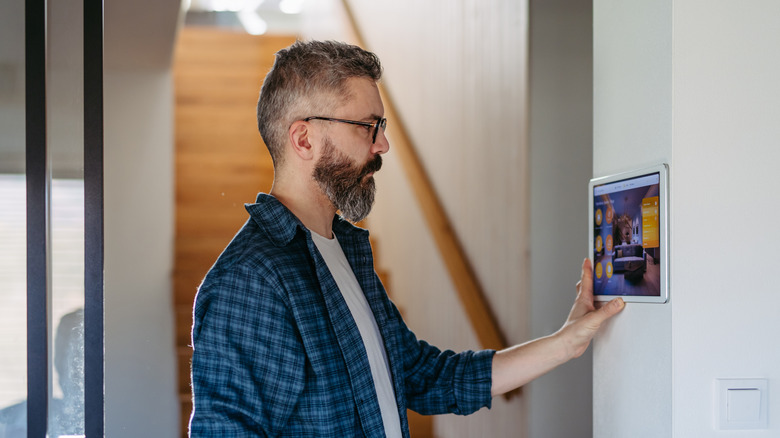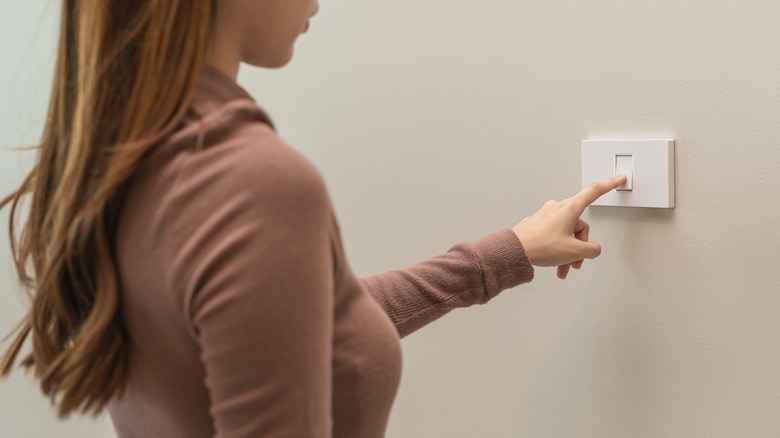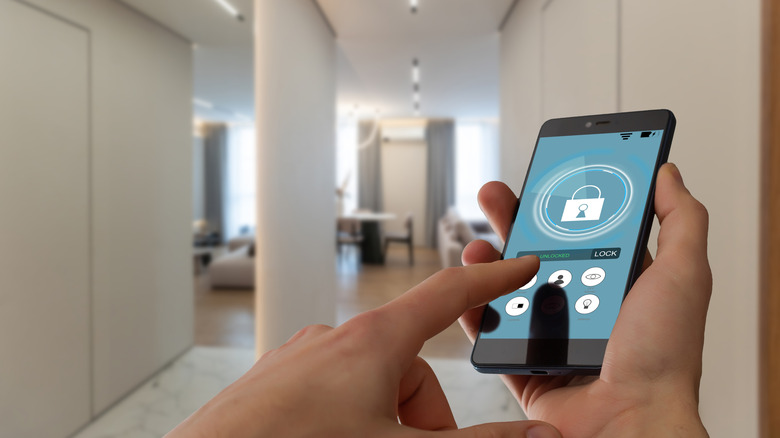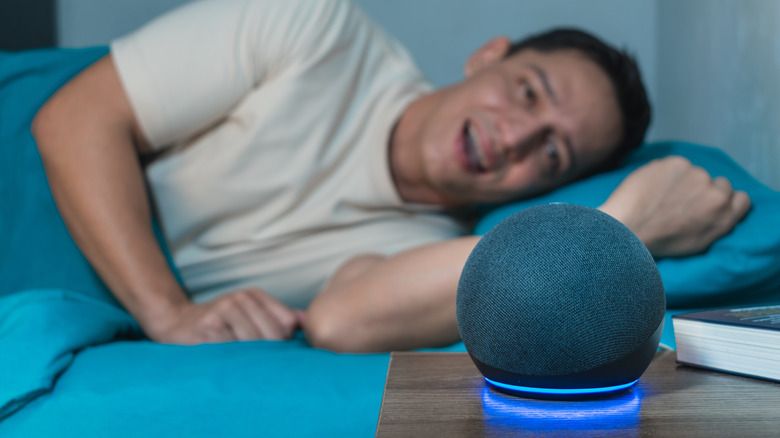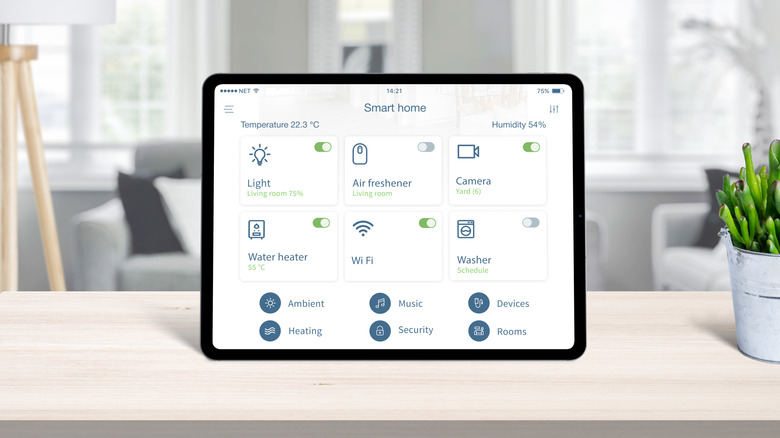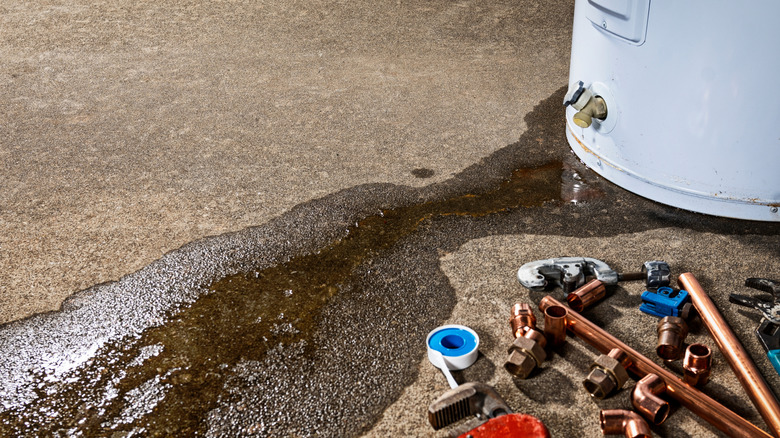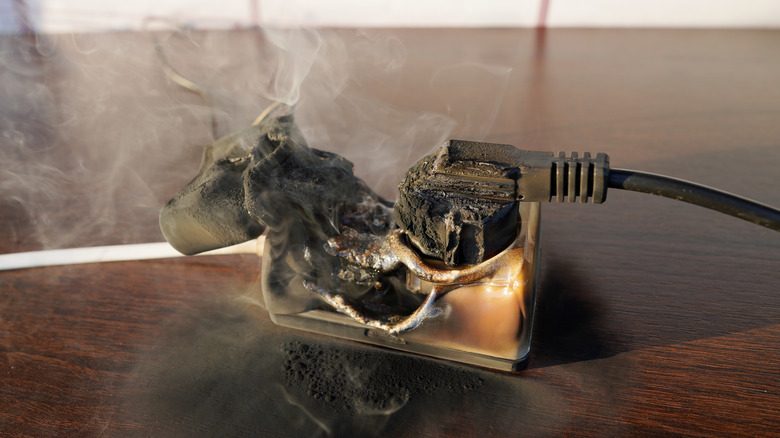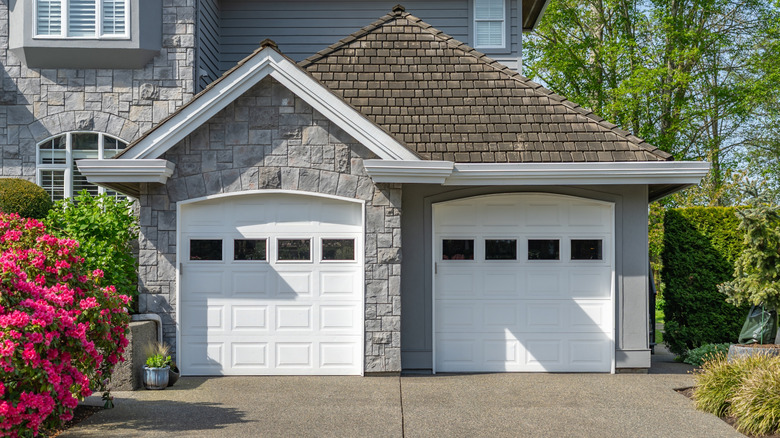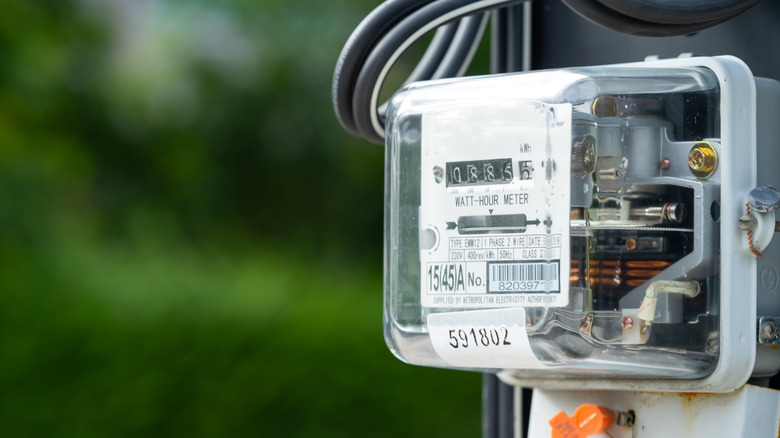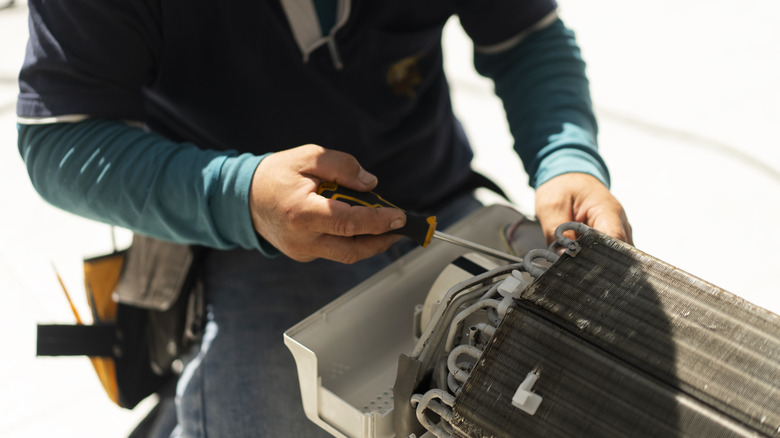13 Benefits Of Smart Home Automation (And Why It's Worth The Hassle Of Setting It Up)
We may receive a commission on purchases made from links.
Setting up smart home automations can feel overwhelming, and at times, downright ridiculous. You might wonder if you really need a machine that can open your blinds for you if your own two hands can do exactly the same thing, or whether you need a smart thermostat that learns when you're at home or away and adjusts the temperature on demand. These automations make less and less sense when you start piling on the cost and time it takes to set up and test them. However, some home automations can add immense value to your everyday life when installed correctly, and not all of them cost a fortune or require technical skills to install.
Keep in mind that there is no single best way to go about setting up home automations. There are tons of tools and services out there that can get the job done. Some are cheap but difficult to implement yourself, while others are more costly but don't require any effort on your part. No matter which path you choose, you're bound to find that some of these smart home benefits will be worth the investment.
Eliminate repetitive daily tasks
Changing the thermostat when you leave, flipping lights on and off, closing blinds, and carrying keys are things we're used to doing every day. And yet, we also forget to do them all the time. This means paying for power you're not using, leaving your home vulnerable, or in some cases, having to call a pricey locksmith to open the lock without a key. Repetitive daily tasks like these aren't hard to do, but the price of forgetting them can be high. Smart home automation can change that.
Some automations can remove the need to do certain tasks every day. For example, you can automatically set your thermostat based on your schedule, tell it to sense when you're home or away, and even heat or cool specific areas of your home instead of the whole house. To set up these automations, think about the home-related tasks you do each day, then see what smart devices there are to automate those tasks. With this kind of automation, the sky's the limit. Smart home solutions span a huge range of tasks, from automated locks, to lighting and AC, and even self-closing windows and shutters. Many of those automations also offer remote access, so you can adjust your schedules even when you're not at home.
Customize your home to match your comfort level
You need a central hub to set up smart home automations, but these are also useful to fine-tune your home to match your personal preferences without lifting a finger (once it's all set up). This might mean adjusting the temperature of the room when you wake up, dimming the lights when the sun sets, or even playing music when you return home — whatever makes the space feel like your own. You can do all those things manually, but you wouldn't be able to adjust the whole scene at once, like a smart home hub would.
You need a central hub to set up complex smart home automations. Google Home, Amazon Alexa, and Apple HomeKit are all solid choices, but not every device is compatible with every hub, so plan ahead. Once you connect your hub to a smart device, like a Nest smart thermostat, Philips Hue lights, and even smart plugs to control "dumb" appliances, you can start creating routines. There is some setting up to do at first, the complexity of which varies depending on how many automations you're creating, but once they're in place, they'll work together to keep your home just the way you like it.
Gain hands-free control of your home
Hands-free control is one of the most immediate, most satisfying benefits of smart home automation. Think about it: You're walking through the door with an armful of groceries and say, "Alexa, turn on the kitchen lights." There's no risk of dropping that jar of pickles as you fumble for the switch. With a simple command of your voice, you can turn on fans, open blinds, or even turn off the hallway light after you're snuggled in bed. Commanding your home with just your voice creates a whole new level of convenience.
To create a hands-free smart home, you'll need to start with a smart speaker, display, or anything else that includes a microphone. Thankfully, many of the best smart home hubs come with an integrated microphone. You will also need to add compatible smart devices that connect to your hub, otherwise you won't have anything to control with your voice. If you want to control the lights in a room, for example, you might have to change some plugs, some light bulbs, and maybe even some of the light switches. Finally, you'll have to use the smart home hub app to set up the devices and create voice commands that will activate them.
Never worry about losing your house key again
If you've ever lost your house key somewhere (or forgot to grab it before you walked out the door), you know the pain of being unable to open your front door. You also know how expensive it is to have a professional open the door for you. Keys are easy to lose, and hiding a spare one outside can be risky or simply impossible. Smart locks offer a safer solution: Just switch your old lock with one controlled by an app, a keypad, or even a fingerprint reader. You're less likely to lose your phone or forget a password than to forget your keys, let alone losing your finger. Some smart locks also let you see who's coming and going from your house, which might be helpful to some, while other models might be able to let you control the door remotely and send alerts when a door is unlocked.
There are quite a few things to know before installing a smart lock, but here's the short version. To upgrade your lock, first you need to choose what to install in its place. Retrofit locks attach to your current deadbolt, so you can keep your existing keys as handy backups. Full replacement locks tend to have more features, like geofencing and keypad codes, but they can be expensive. In either case, you'll need a smart home hub if you want integration with voice assistants. Once your smart lock is installed, you'll be able to provide virtual keys or codes to your household members.
Handle quick-change door lock access
Smart locks are convenient for homeowners, since they don't need to worry about keys anymore, but they can also help control who enters your property and when. This is especially convenient for rental property owners, who are constantly exchanging keys with guests. Smart locks mean no more rekeying locks or tracking down spare keys, and you can grant and revoke access in seconds. Most smart locks will let you generate unique codes for each person and set rules like time-limited access. For example, a friend dropping off groceries would only need access to your house once, while a weeklong bed and breakfast guest would need to come and go multiple times during their booking.
First, you'll want to choose one of the smart home locks that are good for renters, which tend to offer flexible access controls. Schlage Encode and Level Lock are sound options with keypads and remote access via app. They're also pretty easy to install. From there, you can use the app to create digital keys to share with others. Some locks will even let you assign names to each key or code so you can see when they're accessing your property. Syncing these locks to a smart home hub can offer more customization, such as locking the doors through a voice assistant.
Remotely access your home
Smart home automation lets you stay connected to your home even when you're at work, traveling, or running errands. Remote access lets you lock and unlock doors, adjust the thermostat, check cameras, turn lights on and off, and more, all from your phone. To some, this can bring a peace of mind unmatched by other solutions: Did you remember to lock the door? Are the lights on? There's no need to worry until you get back if you can check how your home is doing from anywhere.
To enable remote access, you'll need your smart devices (like the lock, the thermostat, the lights, etc.) to be connected to a smart home hub. Smart devices typically come with their own app, which you can use instead of a smart hub to control their features remotely. Having a reliable home Wi-Fi network is also a must, as your devices will need to stay connected to them in order for you to access them. If you're using a smart hub, you'll be able to control all your devices from one access point.
Get notified about potential issues instantly
Emergencies seem to always happen at the worst possible times, like when you're on vacation or stuck in traffic on your way back from work. This problem, too, can be mitigated with correct use of smart home automations. For example, you could set up a device to alert you when it detects water in an area where water shouldn't be, or place a smart smoke detector in the kitchen that can send notifications on top of beeping non-stop. Finding out about those issues immediately can be the difference between a minor fix and a major expense.
To set up these types of automations, you'll need a set of sensors that can monitor the conditions you're worried about. This might mean buying a smart water leak detector like Govee's Water Sensor or a smart smoke alarm like those made by Nest Protect. Like other smart devices, these sensors connect to your home's Wi-Fi and can send you alerts when they detect a problem, but it's probably worth the effort to connect them to your smart home hub.
Protect your home from potential disasters
Smart homes are all about making your life easier, such as by protecting your home when you're not there. With advanced smart home automations, you can potentially prevent disasters in real time, instead of merely being made aware of those issues as they happen. For example, water shutoff valves will automatically close when they detect a leak, helping to curb water damage and avoid expensive repair bills. Smart plugs can disconnect appliances during power surges, while environmental monitors alert you to changes in temperature or humidity.
Most of these devices are relatively plug-and-play, meaning that they don't require technical knowledge to operate once they're installed. They connect either to your home's Wi-Fi or to a smart home hub, sometimes both, and help to turn your smart home automations into a safety net. These types of solutions cater to people who travel frequently, those who own rental properties, and anyone who values peace of mind while they're away from home.
Monitor your home when you're away
Most smart home automations specialize in keeping your home working a certain way, turning on the lights and whatnot according to routines, but they can also help you keep an eye on things when you're not around. Any camera and sensor connected to a smart home hub becomes a window into what's happening over there. Whether you're waiting for package deliveries, checking in on pets, or simply want to make sure that everything is in order, smart technologies provide a solution.
To set up remote monitoring, you first have to get the right equipment. You can choose from a variety of smart cameras and doorbells. Some cameras, like the Lorex's Discreet AI 2K Lightbulb Camera, are geared for indoor and outdoor surveillance, but they don't look like traditional security cameras. The best smart doorbell cameras, on the other hand, capture short bursts of footage when someone approaches your door, and some even have integrated speakers and microphones, letting you communicate with the people who ring the doorbell, making them ideal to monitor your front door. You typically don't need smart home hubs for these devices, but it doesn't hurt to pair them with the rest of the system.
Deter burglars when you're not home
A vacant home is often the target of burglaries, but smart home automation can make it look like someone's always in there. Kevin McAllister's family had the right idea in Home Alone, putting timers on their lights, and that was all the way back in the 1990s. Today, smart home automation gives you more options: Lights can turn on and off at random, blinds can open and close, and speakers can play music periodically. Used them together, and you might reduce the risk of burglaries significantly.
The easiest way to take advantage of those automations is to use a smart light bulb. There are some things to know about smart light bulbs before you buy one, but once again, we'll skip to the fun part. Once you have some smart LED lights, you can schedule them to turn on and off at certain times, or even randomize their actions. If you don't want to purchase a smart light, you can use smart plugs to control lamps. Set smart blinds to open in the morning and close at night, or use your smart home hub to set up elaborate routines for some of your noisiest appliances. The sky's the limit.
Save money on energy costs
Let's be honest: One of home automation's most attractive benefits is the potential to save you money. If your lights are off, HVAC is idle, and appliances aren't sucking power when you're not home, you aren't paying for power you don't need. All of these little expenses add up, and may even translate to hundreds of dollars in savings per year. Sure, you can turn off the lights and lower the AC's power without home automations, but smart devices like thermostats, lights, and plugs make it a lot easier.
Setting up those automations doesn't have to be hard, either. Smart thermostats like the Nest Learning Thermostat can detect when you're home, learn your schedule, and adjust how and when it operates. Smart plugs and switches manage "phantom power" from devices you leave plugged in, which might lead to power consumption even when you're not using them. You can even automate blinds to block sunlight in the summer, helping to cool your home and lowering the weight placed on the AC. Most of these devices connect to Wi-Fi, letting you control them through their companion app, but most can also be paired with a smart home hub or a voice assistant.
Get real-time data on how your home uses energy
Smart home technology can save energy, but do you know what consumes the most energy in your house? Real-time energy monitoring, available with many smart home devices, lets you see which appliances are power hogs. With this information, you can track trends in how you're using different devices or rooms and make decisions about how and when to use electricity. If you've ever wondered about those mystery spikes in your monthly energy bill, energy tracking might be what finally answers that question.
To best measure your energy consumption, you'll need a good smart home energy monitor from a reliable brand like Sense or Emporia. These monitoring systems connect directly to your electrical panel and break down the energy used by every light and appliance in real-time. This information can come in handy if you're thinking about upgrading to solar energy and need to know how much energy you're using, or if you want to check just how much energy those smart plugs and fancy light bulbs are saving. Ultimately, real-time data empowers you to take smarter steps towards lowering your power bills, reducing waste, and creating a more sustainable home.
Extend the life of your home systems
Smart home automation can help you get more years out of your HVAC and plumbing systems and your appliances. It does so by helping you conserve their use and track performances, as well as the need for maintenance. The more you use something, the faster it will likely break down. Smart monitoring can also detect small issues that would otherwise go unnoticed until they become costly to repair. With a few helpful tools, you can get alerts when something goes wrong and catch issues when they're cheap to fix.
Setting up these automations depends on your system and goal. For example, smart thermostats can track the runtime of your heater and tell you if your system is working harder than normal. Leak detectors can catch minor drips coming from the cracked pipe before it fully breaks, which would cause major damages. Smart plugs let you track how often you use certain appliances or electronics and automatically turn them off when you're not using them. More expensive solutions like Flo by Moen or Sensi Predict claim to predict when water and HVAC systems might need maintenance, which would help you keep expensive emergency repairs at bay.
